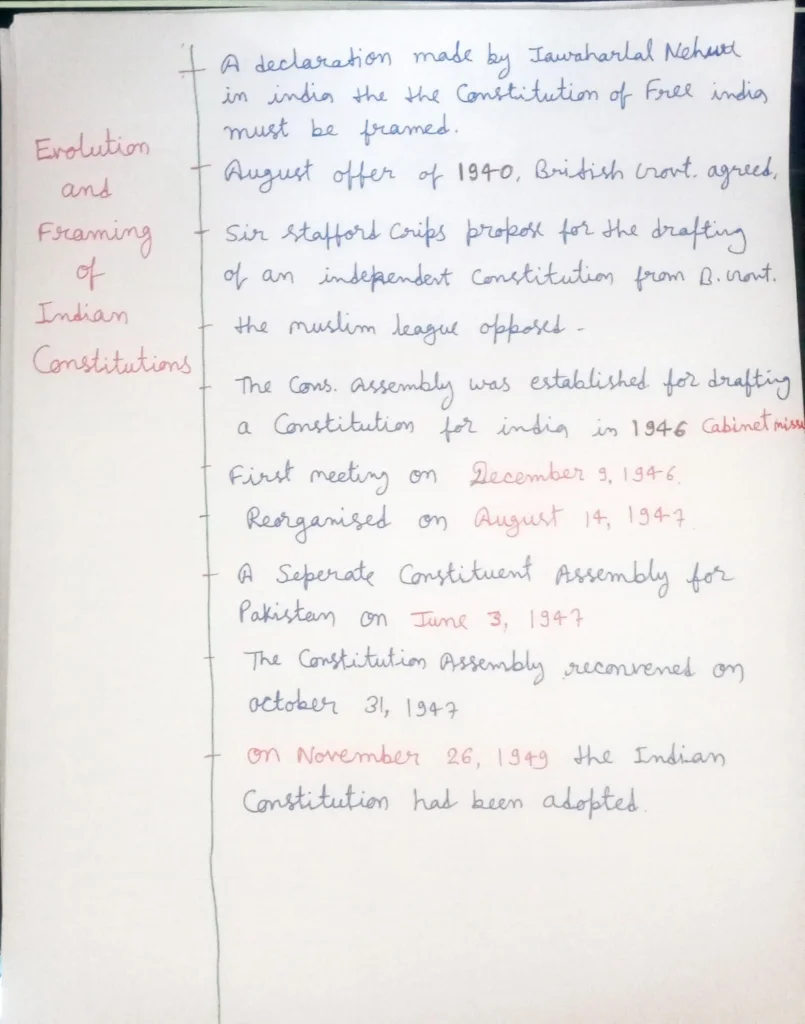Evolution and Framing of Indian Constitutions
M. N. Roy, a leader of India’s communist movement and a supporter of radical democracy, proposed the idea of an Indian Constituent Assembly for the first time in 1934. In 1935, the Indian National Congress (INC) officially demanded a Constituent Assembly to design the Indian Constitution.

Evolution and Framing of Indian Constitutions
- Jawaharlal Nehru made the following declaration in 1938 on behalf of the INC: “The Constitution of Free India must be framed, without outside interference, by a Constituent Assembly elected on the basis of the adult franchise.”
- In what is known as the “August Offer” of 1940, the British Government ultimately agreed in principle to the proposal. A member of the cabinet named Sir Stafford Cripps travelled to India in 1942 carrying a draft proposal from the British government for the drafting of an independent constitution to be implemented after World War II.
- The Muslim League, which desired the division of India into two independent states with separate Constituent Assemblies, opposed the Cripps Proposals. In the end, a Cabinet Mission was dispatched to India. It proposed a plan for the Constituent Assembly that, while it rejected the idea of two Constituent Assemblies, more or less satisfied the Muslim League.
- The Constituent Assembly was established for drafting a constitution for India as part of the Cabinet Mission Plan of 1946. The Constituent Assembly, which was elected to represent undivided India and held its first meeting on December 9, 1946, reorganised on August 14, 1947, as the sovereign Constituent Assembly for the Dominion of India.
- In accordance with the scheme recommended by the Cabinet Delegation, it was elected indirectly by the members of the Provincial Legislative Assembly (Lower House only). The main elements of this plan were as follows:
- The Indian States were given a maximum of 93 seats, while the Provinces elected 292 members. The seats in each province were divided among the Muslim, Sikh, and General major committees according to the populations of those groups.
- Using a single transferable vote and the proportional representation method, members of the Provincial Legislative Assembly elected their own representatives from every community.
- The process of selection for delegates of Indian States was to be established by consolation. As a result of the Partition Plan of June 3, 1947, a separate Constituent Assembly for Pakistan was established. The representatives of Bengal, Punjab, Sind, North-Western Frontier Province, Baluchistan, and the Sylhet district of Assam (which had joined Pakistan by referendum) ceased to be members of the Constituent Assembly of India, and new elections were held in the new Provinces of West Bengal and East Punjab. (As a result, when the Constituent Assembly reconvened on October 31, 1947, the membership of the House was reduced to 299). On November 26, 1949, 284 of these 284 people were actually present.
On November 26, 1949, the Indian Constitution had been adopted.
Sources of Indian Constitution –
On November 26, 1949, the Indian Constitution had been adopted. The Constituent Assembly of India drafted the constitution by incorporating into features of other countries’ constitutions as well as the Government of India Act 1935. Some parts of the Indian constitution are drawn from a variety of sources.
Our constitution incorporates some characteristics from the Government of India Act of 1935.
These characteristics are as follows: • Federal Scheme, Governor’s Office, Judiciary, Public service commissions, emergency provisions and administrative details.
The following provisions were borrowed from several countries and are detailed in the table below:
| Country | Borrowed features from other countries |
| US | Fundamental rights, Independence of judiciary, Judicial review, Impeachment of the president, Removal of Supreme Court and High Court judges, Post of vice President |
| UK | Parliamentary government, Rule of Law, Legislative procedure, Single Citizenship, Cabinet system, Prerogative writs, Bicameralism, Parliamentary Privileges |
| USSR (now, Russia) | Fundamental duties, Ideals of justice (social, economic and political) in the Preamble |
| Australia | Concurrent list, Freedom of trade, Commerce and intercourse, Joint-sitting of the two Houses of Parliament |
| Canada | Federation with a strong Centre, Vesting of residuary powers in the Centre, Appointment of state governors by the Centre, Advisory jurisdiction of the Supreme Court |
| Ireland | Directive Principles of State Policy, Nomination of members to Rajya Sabha, Method of election of the president |
| Japan | Procedure Established by law |
| France | Republic, Ideals of liberty, equality and fraternity in the Preamble |
| Germany (Weimar) | Suspension of Fundamental Rights during emergency |
| South Africa | Procedure for amendment of the Indian Constitution, Election of members of Rajya Sabha |
FAQs
Who has framed Indian Constitution?
The Indian Constitution was drafted by a constituent Assembly established under the Cabinet Mission Plan of 1946. On December 9, 1946, the Assembly had its first meeting and elected Dr. Sachhidannand Sinha (the Assembly’s oldest member) as Provisional President.
Who wrote the Constitution of India?
The Indian Constitution was wrote (calligraphed) by Prem Behari Narain Raizada. He wrote the original constitution in a flowing italic style. Vasant Krishan Vaidya calligraphed for the Hindi translation of the Original Constitution.
How long did Constituent Assembly take to draft the Indian Constitution ?
Constituent Assembly take to draft the Indian Constitution approximately two years, eleven months, and eighteen days(2 years, 11 months & 18 days .
MCQs
Q. 1 Who is the “Father of the Indian Constitution”?
- Dr. B.R. Ambedkar
- Dr. Rajendra Prasad
- Sardar Patel
- Jawaharlal Nehru
Answer (1)
Q. 2 When did India adopt its Constitution?
- August 15, 1947
- December 9, 1946
- November 26, 1949
- January 26, 1950
Answer (3)
Q. 3 Who was the chairman (President) of the Constituent Assembly of India?
- Jawaharlal Nehru
- Sardar Patel
- Dr. Rajendra Prasad
- Maulana Abul Kalam Azad
Answer (3)
Q. 4 What is the significance of the Preamble of Indian Constitution ?
- It defines the structure of government.
- It lists fundamental rights.
- It outlines the duties of citizens.
- It states the ideals and objectives of the Constitution.
Answer (4)
Q.5 Which country influenced the parliamentary system in India?
- United States
- United Kingdom
- France
- Germany
Answer (2)
